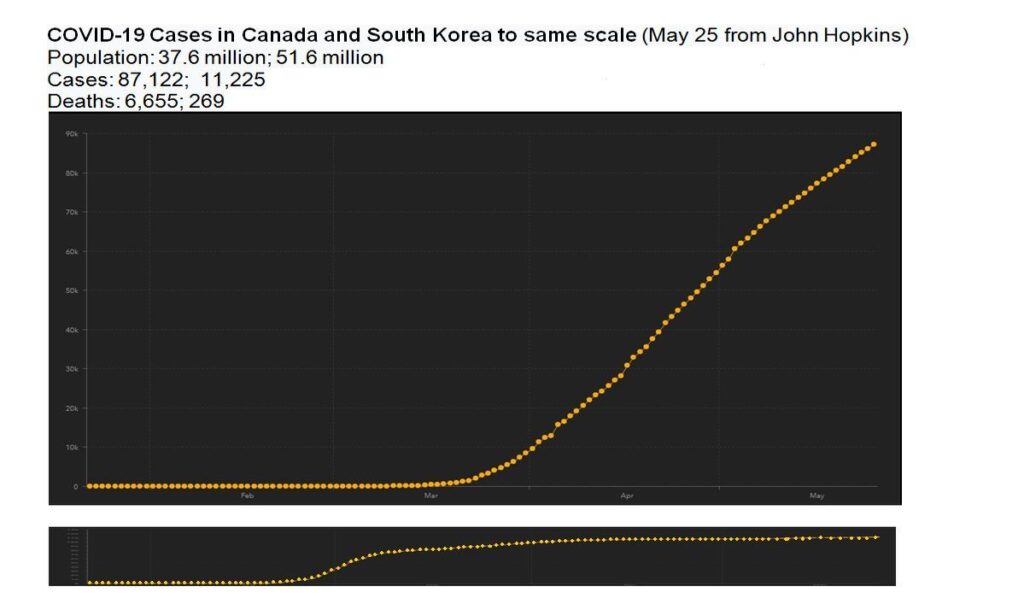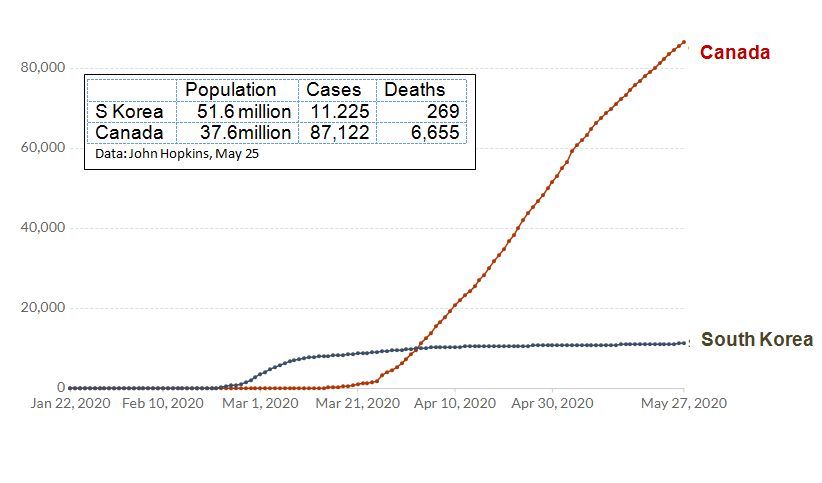Canada is opening up after varying degrees of restrictions due to COVID-19. Retail stores, cafes, bars and restaurants, hairdressers and many workplaces are restarting operations. Of course, many businesses and workplaces deemed essential (some rather dubiously, like building luxury condos or pipelines) never closed.
Schools in most provinces are closed, apart from provision for some children of essential workers, until the end of the summer. Québec, the province worst hit by COVID-19, has re-opened schools and BC is planning to do so on June 1. These are dangerous experiments with children, their families and school workers.
However, there are serious doubts about whether Canada is ready to open up. All the public health officers are warning that there is likely to be an increase in the number of COVID-19 cases. Dr. Lawrence Loh, the Medical Officer of Health for Peel Region, Ontario, stated that opening up in Ontario was “out of step” with the “continuing risk” of COVID-19. Dr. Michael Gardam, chief of staff at Humber River Hospital, Toronto, warned that due to the lack of testing “We’re only ever measuring the tip of the iceberg, and so there’s a bunch of cases out there that we don’t know about, and presumably those cases are transmitting.”
David Fisman, epidemiologist and physician in Toronto, wrote in The Globe and Mail that as COVID is transmitted by people without symptoms it is vital to test widely. “We can’t fight an enemy we cannot see and we can’t see this epidemic without testing.”
Dr. Sandy Buchman, president of the Canadian Medical Association, has clearly warned that Canada is not ready for a second wave of COVID-19. He said, “We’re gambling by reopening,” warning that the health care system was “sick” before the pandemic and is now “breaking down” because of the lack of personal protective equipment (PPE) shortages and physician fatigue. He pointed to continuing lack of testing and tracing.
His views are echoed by Dr. Claire Betker, president of the Canadian Nurses Association, who pointed to the lack of tests, and therefore information about the virus, “we urge an evidence-informed and cautious re-opening.”

How is that Canada still doesn’t have enough PPE or widespread testing? The first identified case in South Korea was on January 20 and was one week later on January 27 in Canada. South Korea could have been a disaster, in mid-February an infected person attended large church services and spread COVID-19 to thousands. However, by the end of January, even before the outbreak, South Korea’s government directed the development of testing kits. In less than four weeks, thousands were being made every day. Four months later, Canada still does not have enough tests! South Korea never had a lockdown – it has controlled COVID-19 by rapid testing and then tracing of cases who are then isolated.
Dr Buchman stated, “We’d never permit a firefighter to go into a burning building without adequate protection. We can’t expect our front-line health care workers to put themselves in harm’s way.” Yet, Canada continues to not have enough PPE. For months, the government announces it has taken action, but still PPE is in short supply.
So far Canada has avoided the horror of Italy, Spain and New York where the health systems were overwhelmed. However, this has been done by leaving seniors to die in “care” homes rather than taking them to hospitals, and drastically reducing all non-emergency surgeries, which will have consequences for other people’s health. However, Montreal is close to a disaster.
Based on the experience in New York it is recommended that hospitals have at least 30 percent of their beds available, in case of a rapid increase of COVID cases. On May 21, Montreal had 23 percent spare beds. Spare capacity in Montérégie, south of Montreal with a population of 1.5 million, was only 16 percent and in Laval, north of Montreal with a population of 430,000, just 5 percent.
It seems the provincial and federal governments are taking a calculated risk with other people’s lives. As Tim Bray, recently-quit Amazon executive explained, “The people who are talking about the urgent need to restart the economy aren’t themselves offering to go out and work. They’re saying, ‘You worker-bees go back and face COVID, and let’s see how that works out.'”
It is true that two months of physical distancing, closed businesses and a lack of wages is taking a toll on people’s health and well-being. But the opening up is not so much about our well-being as big business profits. The prerequisites for a public health-led opening are ample supply of PPE and tests.
To cover up governments’ failing, they are preparing a blame game when the second wave hits. They will say it is not a failing of tests, of tracing and of PPE but instead blame people for not physically distancing. Yet, overwhelmingly people have been sensible and observed the advice – witness empty streets, masks, people passing two metres apart. Of course, it is good policy to maintain distancing policies.
The real failures are the too little too late from governments. Test and PPE should have been mass produced from early February. The millions of low-paid “essential” workers that went to work should have had proper protection and hygiene provisions. All seniors’ homes should have been taken into public control with properly paid and adequate levels of staff after the first death in the Lynn Valley home on March 8. Now the economy is being re-opened without COVID-19 under control in Ontario and Québec and continuing shortages of the necessary tools to find and trace cases, and to protect workers.
Dr. Buchman has warned that the consequences of the lack of PPE, overworked staff and shortage of testing could be catastrophic if the COVID-19 caseload surges later this year. A recent report in The Globe and Mail pointed out that even a 20% increase in contacts between people is likely to send COVID-19 cases increasing again, especially in Ontario and Québec. This suggests that Dr. Buchman’s “if” should read “when.” And what happens when outbreaks occur in areas that so far have escaped COVID-19, such as in the North?
Dr. Arruda, Québec’s public health director warns that “all that we’ve done to get to this point could (turn around) very fast.” Canada would face a second wave of death, job losses and workplace closures.
To prevent this disaster, it is urgent that Canadian unions insist on proper workplace safety for all workers, unionized or not, to reduce the spread, as workplaces such as care homes, meatpacking plants, and construction camps have been major sources of spread.
Socialist Alternative campaigns for full protection for workers from COVID-19 and financial insecurity due to the economic depression. We organize to replace capitalism, that has turned this virus into a human disaster. If you want to join the fight for a socialist Canada and world, click here.



